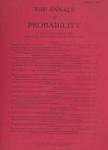-
作者:BRADLEY, RC
作者单位:University of North Carolina; University of North Carolina Chapel Hill
摘要:For strictly stationary random fields indexed by R(d) or Z(d), certain versions of the ''strong mixing'' condition are equivalent to corresponding versions of the ''p-mixing'' condition.
-
作者:KRONE, SM
作者单位:University of Massachusetts System; University of Massachusetts Amherst
摘要:In this work we study local times for a class of measure-valued Markov processes known as superprocesses. We begin by deriving analogues of well-known properties of ordinary local times. Then, restricting our attention to a class of superprocesses (which includes the important case of super-Brownian motion), we prove more detailed properties of the local times, such as joint continuity and a global Holder condition. These are then used to obtain path properties of the superprocesses themselves...
-
作者:ANDJEL, ED
摘要:Bootstrap percolation is a model in which an element of Z2 becomes occupied in one time unit if two appropriately chosen neighbors are occupied. Schonmann [4] proved that starting from a Bernoulli product measure of positive density, the distribution of the time needed to occupy the origin decays exponentially. We show that for alpha > 1, the exponent can be taken as deltap2alpha for some delta > 0, thus showing that the associated characteristic exponent is at most two. Another characteristic...
-
作者:LAHIRI, SN
摘要:Let S(n) denote the nth normalized partial sum of a sequence of mean zero, weakly dependent random vectors. This paper gives asymptotic expansions for Ef(S(n)) under weaker moment conditions than those of Gotze and Hipp (1983). It is also shown that an expansion for Ef(S(n)) with an error term o(n-(s-2)/2) is valid without any Cramer-type condition, if f has partial derivatives of order (s-1) only. This settles a conjecture of Gotze and Hipp in their 1983 paper.
-
作者:MAITRA, A; SUDDERTH, W
摘要:We consider two-person zero-sum stochastic games with limit superior payoff function and Borel measurable state and action spaces. The games are shown to have a value and the value function is calculated by transfinite iteration of an operator and proved to be upper analytic. The paper extends results of our earlier article [17] in which the same class of games was considered for countable state spaces and finite action sets.
-
作者:BOLTHAUSEN, E; DEUSCHEL, JD
作者单位:Swiss Federal Institutes of Technology Domain; ETH Zurich
摘要:We investigate large deviations for the empirical distribution functional of a Gaussian random field on R(Zd), d greater than or equal to 3, in the phase transition regime. We first prove that the specific entropy governs an N-d volume order large deviation principle outside the Gibbsian class. Within the Gibbsian class we derive an N-d-2 capacity order large deviation principle with exact rate function, and we apply this result to the asymptotics of microcanonical ensembles. We also give a sp...
-
作者:KHOSHNEVISAN, D
摘要:We present a Brownian embedding for a broad class of compensated compound Poisson processes. Applications of this method are discussed for a problem of level crossings, as well as Donsker's invariance type of principles. In particular, we give a central limit theorem for local times.
-
作者:CHAGANTY, NR; SETHURAMAN, J
作者单位:State University System of Florida; Florida State University
摘要:Most large deviation results give asymptotic expressions for log P(Y(n) greater-than-or-equal-to y(n)), where the event {Y(n) greater-than-or-equal-to y(n)) is a large deviation event, that is, P(Y(n) greater-than-or-equal-to y(n)) goes to 0 exponentially fast. We refer to such results as weak large deviation results. In this paper we obtain strong large deviation results for arbitrary random variables {Y(n)}, that is, we obtain asymptotic expressions for P(Y(n) greater-than-or-equal-to y(n)),...
-
作者:KESTEN, H
-
作者:CAI, HY; LUO, XL
作者单位:Cornell University
摘要:We prove laws of large numbers for a cellular automaton in the space {0,1,..., p - 1}Z with p being a prime number. The dynamics tau of the system are defined by taueta(x) = eta(x - 1) + eta(x + 1) mod p for eta is-an-element-of X.
